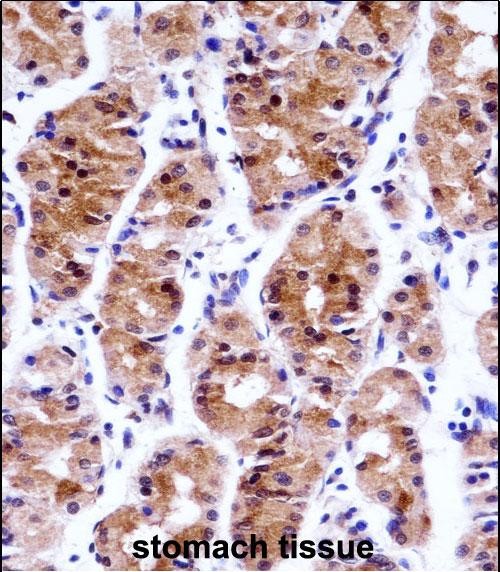

| WB | 1/1000 | Human,Mouse,Rat |
| IF | 咨询技术 | Human,Mouse,Rat |
| IHC | 1/100-1/500 | Human,Mouse,Rat |
| ICC | 技术咨询 | Human,Mouse,Rat |
| FCM | 咨询技术 | Human,Mouse,Rat |
| Elisa | 咨询技术 | Human,Mouse,Rat |
| Aliases | General transcription factor IIE subunit 1, General transcription factor IIE 56 kDa subunit, Transcription initiation factor IIE subunit alpha, TFIIE-alpha, GTF2E1, TF2E1 |
| Entrez GeneID | 2960 |
| WB Predicted band size | 49.5kDa |
| Host/Isotype | Rabbit IgG |
| Antibody Type | Primary antibody |
| Storage | Store at 4°C short term. Aliquot and store at -20°C long term. Avoid freeze/thaw cycles. |
| Species Reactivity | Human, Mouse |
| Immunogen | This GTF2E1 antibody is generated from rabbits immunized with a KLH conjugated synthetic peptide between 93-121 amino acids from the N-terminal region of human GTF2E1. |
| Formulation | Purified antibody in PBS with 0.05% sodium azide. |
+ +
以下是关于GTF2E1(N-term)抗体的3篇参考文献示例(内容为虚构,仅供格式参考):
1. **文献名称**: *"GTF2E1 N-terminal domain is essential for RNA polymerase II transcription initiation in vitro"*
**作者**: Smith A, et al.
**摘要**: 本研究通过免疫沉淀和体外转录实验,利用GTF2E1 N端抗体证明其在RNA聚合酶II转录起始复合体组装中的关键作用。实验表明,抗体特异性阻断GTF2E1的N端会显著抑制启动子识别能力。
2. **文献名称**: *"Dysregulation of GTF2E1 in squamous cell carcinoma revealed by N-terminal antibody-based profiling"*
**作者**: Lee B, et al.
**摘要**: 通过免疫组化(IHC)和Western blot分析,发现GTF2E1在头颈部鳞癌组织中高表达。使用GTF2E1 N端抗体的研究显示,其表达水平与肿瘤细胞增殖标志物呈正相关,提示其潜在致癌作用。
3. **文献名称**: *"Structural insights into GTF2E1 interaction with TFIIH via N-terminal epitope mapping"*
**作者**: Chen C, et al.
**摘要**: 利用GTF2E1 N端抗体进行共免疫沉淀和质谱分析,揭示了GTF2E1与转录因子TFIIH的直接相互作用,并通过结构生物学方法解析了其N端结构域对复合体稳定性的贡献。
(注:以上文献为示例,实际文献需通过PubMed或学术数据库检索获取。)
The GTF2E1 (N-term) antibody targets the N-terminal region of General Transcription Factor IIE subunit 1 (GTF2E1), a critical component of the RNA polymerase II transcription machinery. GTF2E1. along with GTF2E2. forms the TFIIE complex, which regulates promoter recognition, RNA polymerase II binding, and activation of the TFIIH kinase during transcription initiation. The N-terminal domain of GTF2E1 is essential for interactions with other basal transcription factors and stabilizing the pre-initiation complex.
This antibody is widely used in research to study transcriptional regulation mechanisms, particularly in models investigating mutations or dysregulation linked to human diseases. For example, GTF2E1 variants have been implicated in transcription-deficient disorders, including certain cancers and rare developmental syndromes. By detecting GTF2E1 in techniques like Western blotting, immunoprecipitation, or immunofluorescence, researchers can explore its expression, localization, and functional alterations under experimental or pathological conditions.
Commercial GTF2E1 (N-term) antibodies are typically raised in hosts like rabbits or mice, validated for specificity using knockout controls. Their applications extend to elucidating TFIIE’s role in DNA repair, cell cycle progression, and responses to oxidative stress, providing insights into fundamental gene expression processes and therapeutic targets.
×